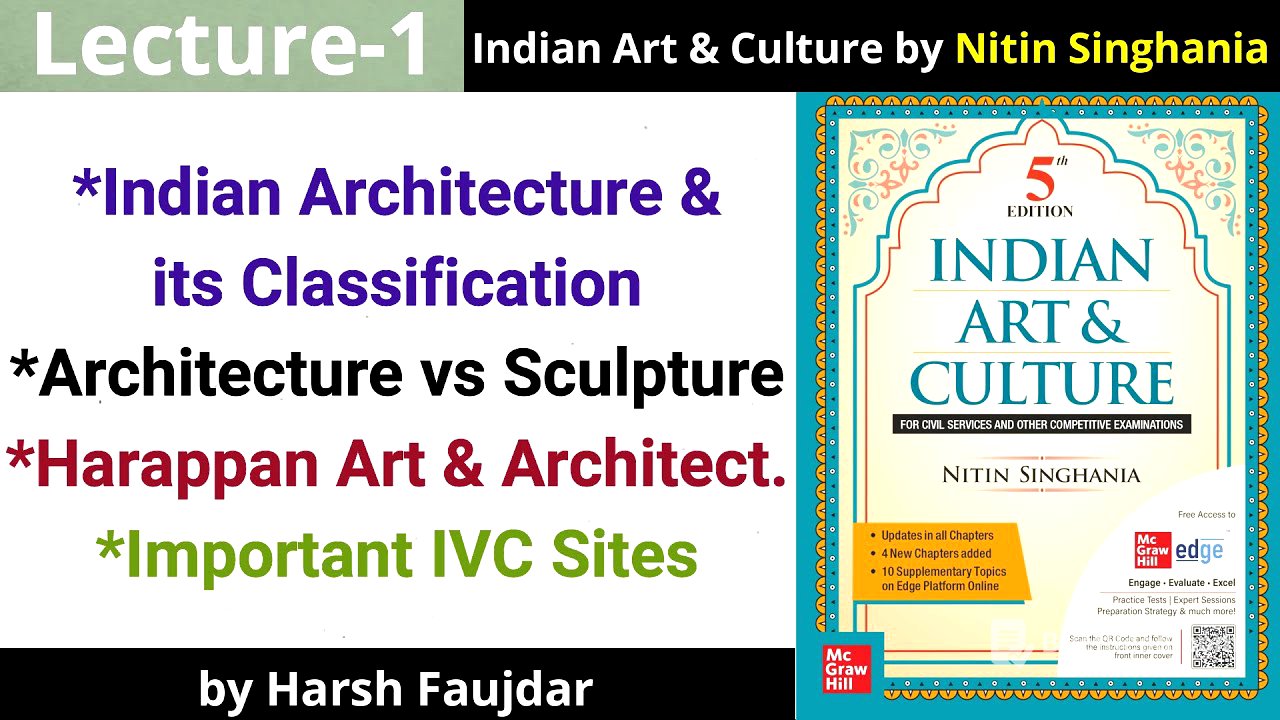TLDR;
This video provides a detailed introduction to Indian Art and Culture, focusing on the first chapter of Nitin Singhania's book. It differentiates between architecture and sculpture, classifies Indian architecture into ancient, medieval, and modern periods, and explores Harappan art and architecture, including town planning, key sites, and significant findings.
- Architecture vs. Sculpture: Architecture involves building design and construction using various materials with engineering precision, while sculpture focuses on smaller, three-dimensional art using single materials, emphasizing creativity.
- Classification of Indian Architecture: Divided into Ancient, Medieval, and Modern periods, with Ancient India further categorized into Harappan, Mauryan, Post-Mauryan, Gupta, and South Indian art.
- Harappan Civilization: Known for urban planning, advanced drainage systems, and the use of burnt mud bricks, with key sites like Harappa and Mohenjodaro showcasing remarkable town planning.
Introduction to Indian Art and Architecture [0:29]
The session begins with an introduction to Indian Art and Culture using Nitin Singhania's book. The initial focus is on differentiating between architecture and sculpture. Architecture is derived from the Latin word "tecton," meaning builder, and involves the design and construction of buildings. Sculpture originates from the Proto-Indo-European word "Kale," meaning to bend, and refers to smaller, three-dimensional works of art. Architecture emphasizes engineering, mathematics, and precise measurements, while sculpture prioritizes creativity and imagination. Examples of architecture include the Taj Mahal and Red Fort, while sculptures include images of Nataraja and dancing girls. Indian architecture reflects the evolution of the country from the Indus Valley Civilization to British rule, showcasing different phases of development, such as religious dominance (temples) and prosperity (Taj Mahal).
Classification of Indian Architecture [6:55]
Indian architecture is classified into three main phases: Ancient India, Medieval India, and Modern India. Ancient Indian architecture includes Harappan, Mauryan, Post-Mauryan, Gupta, and South Indian art. Medieval India features art and architecture from the Delhi Sultanate and Mughal periods. Modern India includes Indo-Gothic and Neo-Roman styles. This classification provides a structured approach to understanding the diverse architectural styles that have evolved throughout India's history.
Harappan Art and Architecture [8:03]
The Harappan civilization, also known as the Indus Valley Civilization, flourished around 2500 BC on the banks of the Indus River in North West and Western India. Key cities like Harappa and Mohenjodaro exemplify urban civic planning with planned road networks, houses, and advanced drainage systems. These cities followed a rectangular grid pattern with roads running in North-South and East-West directions, intersecting at right angles. Three types of buildings were common: dwelling houses, public buildings (like granaries), and public baths, which represented rituals. Burnt mud bricks of standardized dimensions were used for construction, joined with gypsum mortar. Cities were divided into two parts: a raised Citadel on the western side with important buildings and a lower part where the working class lived. Large monumental structures like temples and palaces were absent. Public baths and advanced drainage systems were significant features. The Mesopotamians referred to the Indus Valley Civilization as Melua.
Important Harappan Sites [19:25]
Various Harappan sites reveal specific artifacts and features. Harappa (in present-day Pakistan, discovered by Dayaram Sahni) features two rows of six granaries, stone symbols of Lingam and Yoni, a sculpture of Mother Goddess, wheat and barley in wooden mortars, a bronze sculpture of a dog chasing a deer, the coffin burial system, a male torso of red seed stone, dice, a copper scale, and a mirror. Mohenjodaro (also in present-day Pakistan) contains an Apress Citadel, the Great Bath, large granaries, post-cremation burial, a sculpture of a bearded priest, a bronze statue of a dancing girl, the Pashupati seal, and the unicorn motif. Dholavira (Gujarat) is the largest discovered Indus Valley Civilization city, locally called Kotada Timba, and features joint water reservoirs, a water harnessing system, a stadium, dams, embankments, and a unique three-part division (Citadel, middle town, and lower part). Lothal (Gujarat) is known as the Manchester of Indus Valley Civilization, with fire alters, painted jars, evidence of modern-day chess, naval trade, a dockyard, rice husks, terracotta figures of horses and ships, the practice of burial, and angle measuring instruments. Rakhigarhi (Haryana) is the largest site of Indus Valley Civilization and is called the Provincial Capital of Harappan Civilization, featuring a granary, cemetery, and terracotta bricks. Ropar (Punjab) is the first Harappan site discovered after independence, with dog burials alongside humans in oval pits and copper axes. Surkotada (Gujarat) contains the first actual remains of horse bones. Banawali (Haryana) features a toy plow, barley grains, Lapis Lazuli, fire alters, and oval-shaped settlements with radial streets. Alamgirpur (Uttar Pradesh) is the easternmost site of the Indus Valley Civilization. Balathal and Kalibanga (Rajasthan) contain bangle factories and evidence of camel bones. Mehargarh (Pakistan) is considered a predecessor to the Indus Valley Civilization, a Neolithic archaeological site with the oldest evidence of the lost wax technique and early agricultural communities. Chanudaro (Pakistan) is known as the 'L'shire of India, the only city without a citadel, and features a weed-making factory and lipsticks. Sutka Gendour (Pakistan) is the westernmost site, Damabad (Maharashtra) is the southernmost site, and Maand (Jammu & Kashmir) is the northernmost site. Sand (Haryana) contains the earliest evidence of garlic, Keralano Doro (Gujarat) was a salt production center, and Kotbala (Pakistan) contains the earliest evidence of a furnace.
Ports and Additional Points [35:44]
The Indus Valley Civilization had several important ports, including Lothal, Kaz, Kotwala, Kunt Sai, Rangpur, and Surkotada. Lapis Lazuli deposits were found in Sare Sangha, Afghanistan, indicating trade connections. Cinnabar was used to produce lipstick in Chanudaro. Remains of Rhinosaurus have been found in Amri, and evidence of vermillion has been seen. Balakot was a specialized center for making shell objects.









